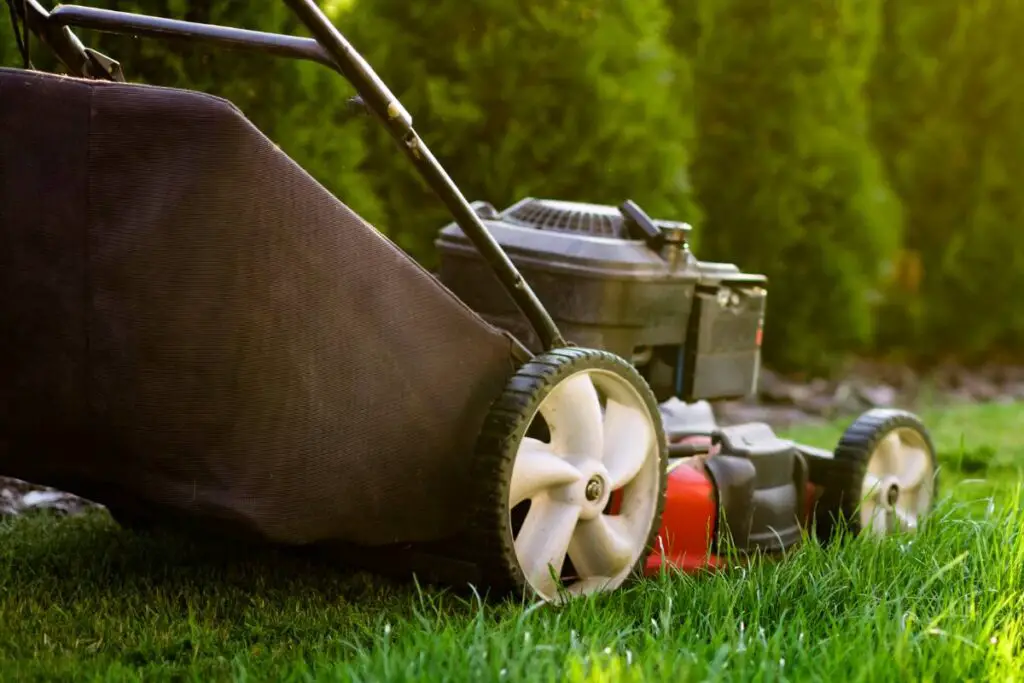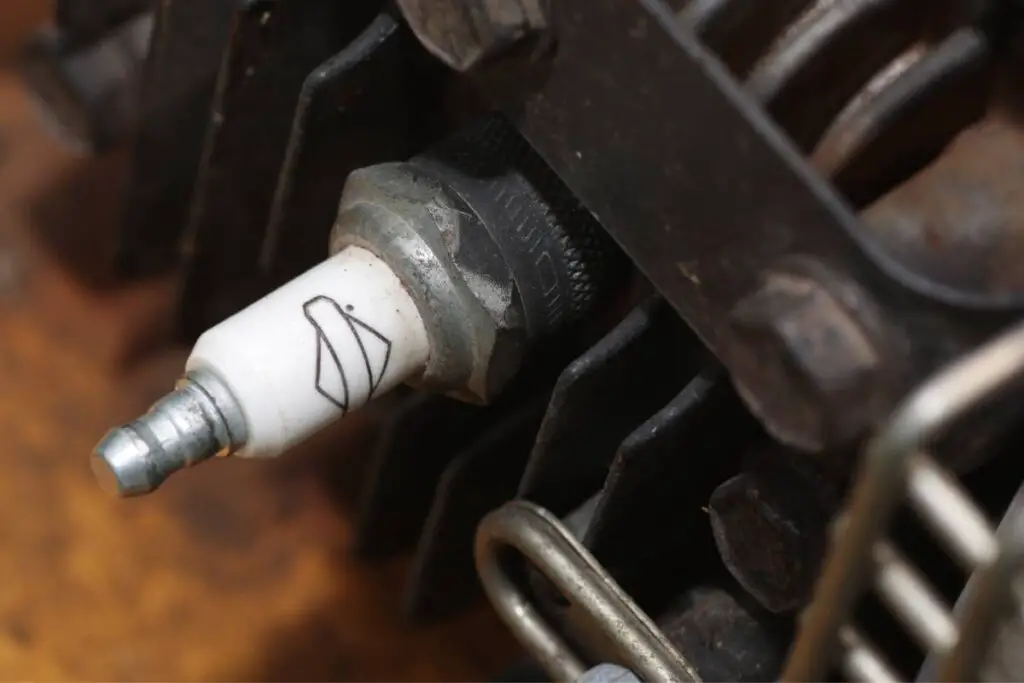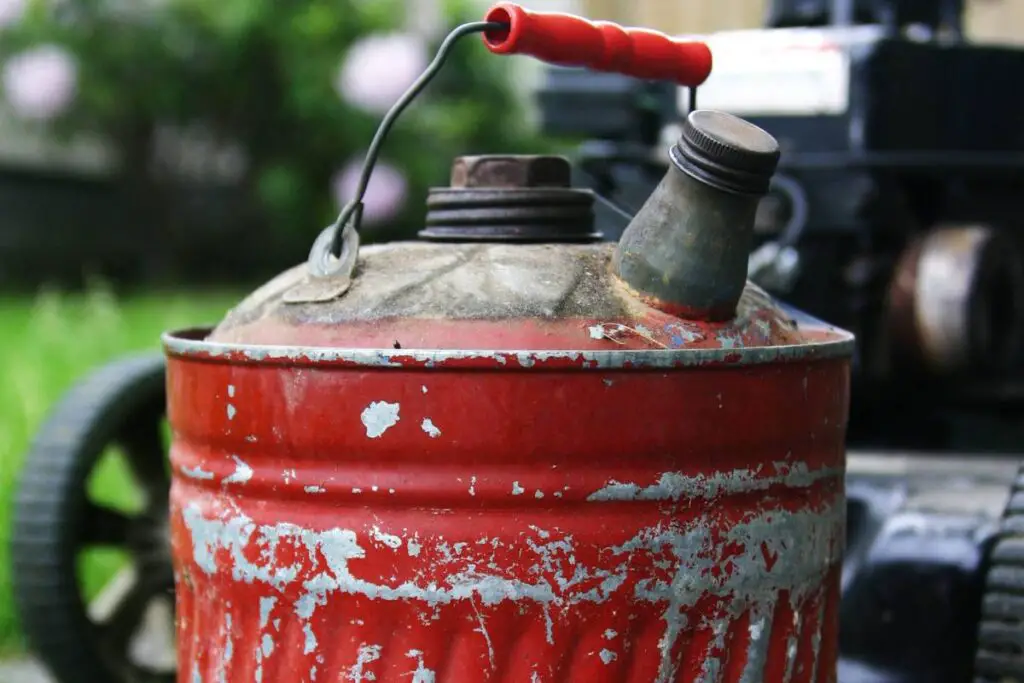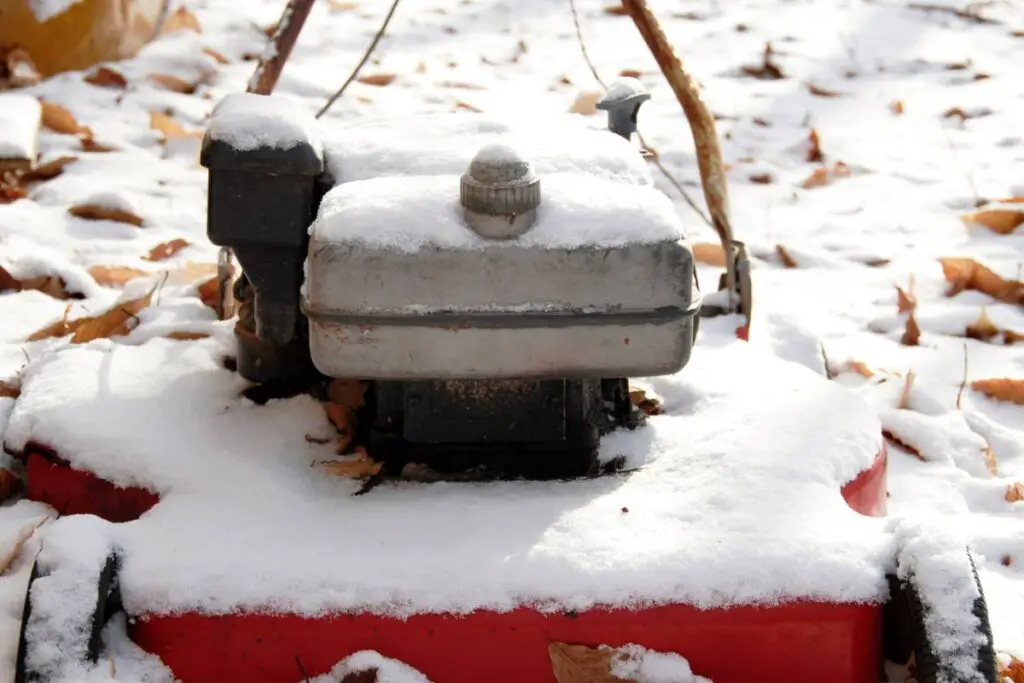There can be many reasons you need to drain the gas/fuel from the tank of your push lawnmower. One of the most common reasons is when you plan to drain the gas before winterizing.
Not emptying the gas/fuel on time can cause serious problems to your lawnmower’s engine, like rusting, corrosion, leakage in the fuel lines, etc.
But what to do when you don’t have a siphon to drain the gas from the fuel tank?
You don’t have to worry about it because you need to follow some simple ways, and it will hardly take 30 minutes to drain the gas without the siphon.
This article will discuss those simple ways to make it possible for you to drain gas without a siphon.

How to drain gas from the lawnmower’s tank without a siphon?
Draining the gas from the lawnmower’s fuel tank depends on two main things.
There should be a proper link between gasoline in the fuel tank and a container.
And a good air pressure that gives force to the gas/fuel for passing through the hoses/ tubes to the container.
Let’s discuss the following steps to know how you can drain the gas without a siphon:-
1. Arrange the needed instruments
If you plan to remove the gas from the gas tank, you should make arrangements for the necessary instruments.
At first, you will need a gas-resistant container for disposing of the gas from the fuel tank.
You can use an oil collector drain pan if you don’t have a gas resisted container.
This oil collector drain pan is made of metal with heightened corners to store the old gas.
After that, you will require a tube for draining the gas.
Visit any lawnmower appliances store and purchase drain tubes or hoses.
You can get it easily as it is a very common thing to use.
Then you will also need a towel or rag not to close the sides of the gas tank.
2. Keep the lawnmower in a safe place and detach the spark plug

Try to park your lawnmower on a plain surface.
It is always necessary to do all these tasks on a stable surface; otherwise, it can cause serious issues to the lawnmower’s engine and gas tank.
At first, use the brakes to stop the lawnmower on a well-ventilated and plain surface and detach the spark plug to turn off the ignition completely.
It is important to do so that the engine doesn’t accidentally start during the draining process.
After that, you can uncover the gas tank cap.
Looking for gardening supplies? We have tested 100's of products before recommending them to you guys. Check out our best pick below:
| Image | Gardening Supplies | Best Price? |
|---|---|---|
 Top
Top Top
Top | Raised Garden Bed Kit | Check On Amazon |
 | XLUX Soil Moisture Meter, Plant Water Monitor, Soil Hygrometer Sensor for Gardening, Farming, Indoor and Outdoor Plants, No Batteries Required | No Results |
 Top
Top Top
Top | 82 Pcs Garden Tools Set and Extra Succulent Tools Set | Check On Amazon |
 | Joeys Garden Expandable Garden Hose with 8 Function Hose Nozzle, Lightweight Anti-Kink Flexible Garden Hoses, Extra Strength Fabric with Double Latex Core, (50 FT, Black) | No Results |
 Top
Top Top
Top | Dual Chamber Compost Tumbler | Check On Amazon |
 Top
Top Top
Top | Sunnyglade Plant Stakes | Check On Amazon |
 Top
Top Top
Top | Organic Cold Pressed Neem Seed Oil | Check On Amazon |
 Top
Top Top
Top | Mighty Mint Gallon :-Insect and Pest Control Peppermint Oil | Check On Amazon |
 Top
Top Top
Top | Scotts DiseaseEx Lawn Fungicide | Check On Amazon |
 Top
Top Top
Top | Jacks Classic 20-20-20 All Purpose Fertilizer | Check On Amazon |
 Top
Top Top
Top | 30,000 Seeds Pollinator Attracting Wildflower Mixture | Check On Amazon |
 Top
Top Top
Top | Survival Vegetable Seeds Garden Kit-Over 16,000 Seeds | Check On Amazon |
3. Connect the tube/hose correctly
You will need 2 tubes or hoses to connect it to the lawnmower’s tank and make sure it is transparent so that you can see the fuel running from the gas tank.
This is the alternative method of using a siphon.
One tube must be long enough to reach the fuel tank of the lawnmower.
And the other tube can be shorter as it is used to generate air pressure.
Then keep the empty container beside the fuel tank to collect the fuel.
If you want to collect the fuel properly, you must keep a container lower than the base of your gas tank.
Afterward, place the longer hose/tube into the lawnmower’s gas tank.
Make sure the tube is completely immersed in the fuel. You will get the best results when the tube reaches the bottom of the fuel tank.
Then, keep the other end of the longer tube inside the drain container.
Then bring the shorter hose/tube and place it beside the longer tube into the fuel tank.
But make sure the shorter tube is not getting in contact with the fuel in the gas tank.
The main motive of the shorter tube is to generate air pressure by blowing into it.
4. Close the fuel lid
After inserting both tubes properly, you must close the fuel lid from the sides where the tubes were placed to stop the airflow.
The airflow should insert only from the shorter tube, not from the sides.
This is because the airflow through the shorter tubes helps to build up the air pressure that forces the fuel to come out from the fuel tank.
You can use a wet towel or rag to close the fuel lid from the sides.
This is because the wet cloth sticks to the object properly with no airflow in between.
5. Empty the fuel tank

After sealing the sides, you can start the draining process.
You must build a dynamic force to push out the fuel to empty the tank.
Grab the shorter tube and blow strongly to thrust air into the fuel tank until the fuel pushes out from the gas tank to the drain container.
It will be easier to do this task when you have an air pump compressor.
But even if you don’t have one, don’t worry because blowing the air works the same.
Also, look over the sides to see whether they are completely sealed; otherwise, the fuel will not come out of the tube.
If you’re clearing out the old fuel, ensure you don’t breathe the fumes excessively, as it can harm your health.
After some blows, you will notice the fuel leaking from the tube to the drain container.
If the fuel flows continuously, you can stop blowing the tube as force and gravity do the rest of the work.
If you don’t want to drain out all the fuel, you can stop the flow by uplifting the drain container or raising the tube.
6. Detach the carburetor connections and uncover the drain tube
You must detach the carburetor connections to remove the remaining fuel from the gas tank.
At first, keep the oil collector drain pan below the gas tank, and then look for the fuel line in your lawnmower. Especially check below the air filter.
Then disconnect the fuel line, which links the gas tank and the carburetor.
When you drain the fuel by a siphoning process, this is always possible that fuel is left in the gas tank.
If you notice no fuel line in your lawnmower, check for the tube or drain plug connected to the carburetor instead of that.
It just depends on the type of lawnmower you have.
Instead of a fuel line, you can detach the tube or drain plug to remove the remaining fuel from the gas tank.
7. Run a push lawnmower
Suppose you don’t want to drain the remaining fuel by disconnecting the carburetor.
In that case, there is another option that you can follow.
First, remove the hoses/tubes from the gas tank and close it.
Make sure you immediately close the container, as fuel is sensitive and can be damaged quickly.
You will notice there is always a little bit of fuel in the fuel tank, even after draining it with the tubes.
It would be best if you connected the spark plug again and then turn the engine on to get rid of that.
Then run the lawnmower all over your lawn until the fuel drains completely.
Now your lawnmower’s gas tank is empty as you wanted.
Draining the fuel from your push mower without a siphon by detaching the fuel line
- Place the mower properly: First, place the lawnmower on a high surface. You can do the task more easily when your lawnmower is raised. If you plan to tip the lawnmower over on its side, avoid doing that. You might end up tipping over on the wrong side.
- Locate the fuel line: Then check where the fuel line is located in your lawnmower. The location is different in different models. You will see a small pipe connected to the gas tank and the carburetor. Most fuel lines are located just behind the air filter. So, you can look at those places.
- Get ready with the drain container: Before draining the fuel from the gas tank, keep a drain container just below the gas tank to avoid any fuel wastage.
- Detach the fuel line: Once you know where the fuel line is located, you will see that both sides of the fuel line are attached to the clips. To remove those clips, take pliers and move the clips down in the middle. Now you can remove the fuel line by using your hands. Before removing, ensure you are holding the drain container close to the gas tank. Then remove the hand from the fuel line end and collect the fuel in the container.
Benefits of draining gas by detaching the fuel line

Let’s discuss the benefits of draining gas by detaching the fuel line:
1. Extract dirt from the fuel tank
Draining the fuel using a tube doesn’t help extract the dirt from the fuel tank.
But by disconnecting the fuel lines, you will be able to get rid of all the dirt present in the gas tank.
A clean tank helps the engine to work smoothly, so it is one of the preferable methods to follow for draining the gas.
2. Regular maintenance
Once you have detached the fuel line, it is always better to look for the other parts of the lawnmower, like fuel filters.
So, draining the fuel by disconnecting the fuel line encourages people to do regular maintenance without being lazy.
For example, you can inspect the fuel filter, clean the float bowl, check the air filter, etc.
So, once you have removed the fuel line, you can go along with the regular maintenance of the lawnmower.
3. Helps in inspecting the fuel line
While working with the fuel line, you can see whether there is any gas leakage in the pipe.
If the pipe is leaking and broken, you can replace it.
A broken fuel line can be very dangerous for the lawnmower and the owner.
So, you can do a regular inspection of this by this method.
Tips to follow
There are 2 tips you should follow while performing this task:
- Always drain the fuel in an aerated environment: The fuel always releases carbon monoxide gas when it’s draining. You may not know because the gas is colorless and doesn’t include any smell. If you inhale carbon monoxide gas excessively, you can suffer from various health problems because of its toxicity. That’s why it is recommended that you should always perform the draining process task in an aerated environment.
- Remove any combustion source: While planning to drain the fuel, you should keep all the sources away from the fuel. Even a tiny ash of a matchbox or cigarette can cause combustion in the fuel. It can be risky when you are draining the fuel in huge quantities.
How often to drain the gas/fuel from the lawnmower?

If the gas/fuel is stored for almost two months or more, you should immediately drain it.
Keeping the gas/fuel for a prolonged period can spoil them, which can cause damage to the engine and other parts of the lawnmower.
Even if you want to keep it for longer, you must use a fuel stabilizer.
You can add the stabilizer frequently to the gas/fuel to keep it healthy.
Final words
If you are wondering if it is difficult to drain gas/fuel from the lawnmower without using a siphon, then you are wrong.
If you don’t have a siphon, you will just require tubes, a drain container, and a wet cloth from the stores.
Then you can easily drain the fuel by generating air pressure inside the gas tank.
But if you want to avoid this siphoning process, you can simply remove the fuel line from the carburetor.
Both methods work fine. Now, it depends on you which method you want to choose.
Reference: Lawn Mower Technology, Lawn Mower Safety, Lawn Mowing, Lawn Care, Mowing your lawn.
